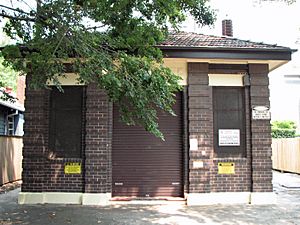Double Bay Compressed Air Ejector Station facts for kids
Quick facts for kids Double Bay Compressed Air Ejector Station |
|
|---|---|

Double Bay Compressed Air Ejector Station
|
|
| Location | Cross Street, Double Bay, Municipality of Woollahra, New South Wales, Australia |
| Built | 1895–1896 |
| Architect | New South Wales Department of Public Works |
| Owner | Sydney Water |
| Official name: Double Bay Compressed Air Ejector Station; Double Bay Sewage Ejector Station No 1 (decommissioned) | |
| Type | State heritage (built) |
| Designated | 18 November 1999 |
| Reference no. | 1324 |
| Type | Other - Utilities - Sewerage |
| Category | Utilities - Sewerage |
| Builders | New South Wales Department of Public Works |
| Lua error in Module:Location_map at line 420: attempt to index field 'wikibase' (a nil value). | |
The Double Bay Compressed Air Ejector Station is a special old building in Double Bay, Sydney, Australia. It used to be a sewage pumping station, which means it helped move wastewater. It's now closed down but is protected because of its history.
This station was designed and built between 1895 and 1896 by the New South Wales Department of Public Works. It's also known as Double Bay Sewage Ejector Station No. 1. Today, it's owned by Sydney Water, a government agency. It was added to the New South Wales State Heritage Register on 18 November 1999, which means it's an important part of the state's heritage.
Contents
How Sydney's Sewers Changed
Back in 1859, Sydney's wastewater system was very basic. Five main sewers simply drained into Sydney Harbour. By the 1870s, the Harbour became very dirty because of this.
To fix the problem, the government created a health board. This led to new, bigger sewers being built in 1889. One was the Bondi Ocean Outfall Sewer (BOOS), which took sewage out to the ocean.
Pumping Stations for Low Areas
Some low-lying areas around the Harbour couldn't use these new sewers. Their wastewater couldn't flow uphill by itself. So, special "low-level pumping stations" were needed. These stations would collect the sewage and pump it up to the main sewer lines.
The Double Bay area was one of the first to get these new stations. In 1898, the Public Works Department built five special machines called "compressed air ejectors" here. These helped move sewage to the BOOS until 1929.
By the early 1900s, many more low-level pumping stations were built around Sydney Harbour. Today, Greater Sydney has over 600 of these stations!
What the Ejector Station Looks Like
The Double Bay Sewage Ejector Station No. 1 is hidden underground. It's located beneath the road surface of Cross Street.
Inside the Station
The main part of the station is a large steel cylinder, about 3 meters (10 feet) wide. This cylinder is called a "caisson." Wastewater would flow into this caisson through a special one-way valve.
When the caisson was full, a float inside would trigger a valve. This valve would then let compressed air into the cylinder. The air would push the wastewater out, forcing it up a pipe called a "rising main." This pipe then carried the sewage to the main gravity sewer.
The top of the ejector equipment is about 3.35 meters (11 feet) below the road. The compressed air that powered it came from a separate compressor station nearby.
Old Inscriptions
You can still see some old writing on the steel caisson. It says, "Pope Maher and Co Sydney 1896 Darlington Iron Works." Other parts of the equipment have inscriptions like, "Shone and Aults Patent Manufactured by Hughes and Lancaster London Nos. 438 and 447, 1896." These tell us who made the parts and when.
Changes Over Time
Today, the steel caisson has been filled with sand. This means it no longer works as a pumping station.
Why It's a Heritage Site
The Double Bay Sewage Ejector Station No. 1 is important for several reasons. It has historical and technical value.
Historical Importance
- It was the first low-level sewage pumping station built in Sydney in 1898.
- It's the only one left of the five ejector stations originally built in Double Bay.
- It played a key role in the early days of the Bondi Ocean Outfall Sewer. It helped provide proper sewerage for Sydney's low-lying areas.
Scientific and Technical Importance
- This station can teach us about the "Shone ejector principle." This was a clever way to pump liquids, especially those with solid waste, using compressed air.
- This old technology was later replaced by modern electric pumps.
- Because it's so unique and old, the remaining parts of the station are very valuable for archaeological study.
Rarity
The Double Bay Ejector Station No. 1 is unique. It was the first low-level station to serve Sydney. It's also the only known "Shone Ejector" left from the five built in Double Bay.
Example of Technology
This station is a good example of how low-level sewage pumping stations worked in the past using the Shone Ejector system.

